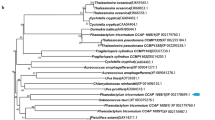Abstract
We collected centric diatomStephanopyxis palmeriana samples in coastal waters of Xiamen for characteristic red light/far red light (R/FR) phytochrome reactions to identify its photoreceptor in the course of sexual reproduction. The result showed that pre-illumination of 2–3h red light before darkness could induce sexualization ofS. palmeriana, while the follow-up illumination of far red light could reverse the effect of red light, which is a featured reaction of phytochrome. The Southern Dot Blot was carried out to identify the type of phytochrome that induces the sexualization. The result also showed high homogeneity of DNA fragment ofS. palmeriana with phyB, but phyA. This means the photoreceptor in the process of sexual reproduction ofS. palmeriana is phytochrome B (phyB).
Similar content being viewed by others
References
Borthwick, H. A., S. B. Hendricks, M. W. Parker, E. H. Toole and V. K. Toole, 1952. A reversible photoreaction controlling seed germination.Proceedings of the National Academy of Sciences of the United States of America 38: 662–666.
Dring, M. J., 1967. Phytochrome in red algaePorphyra tenera.Nature 215: 1 411–1 412.
Dring, M. J., 1988. Photocontrol of development in algae.Annual Review of Plant Physiology and Plant Molecular Biology 39: 157–174.
Flint, L. H. and E. D. McAlister, 1937. Wave lengths of radiation in the visable spectrum promoting the germination of light-sensitive lettuce seed.Smithsonian Miscellaneous Collections 96(2): 1–9.
Guillard, R. R. L. and J. H. Rvther, 1962. Studies of marine planktonic diatoms. I.Cyclotella nana Hustedt andDetonula convervacea (Cleve)Gran.Can. J. Microbiol. 8: 229–239.
Hirschfeld, M., J. M. Tepperman, T. Clack, P. H. Quail and R. A. Sharrock, 1998. Coordination of phytochrome levels in phyB mutants ofArabidopsis as revealed by apoprotein-specific monoclonal antibodies.Genetics 149: 523–535.
Hu, R., J. M. Lin, Q. Q. Lin, B. P. Han and T. L. Wang, 2003. Light effect and photo-receptor in the sexual reproduction process ofStephanopyxis palmeriana.Journal of Plant Physiology and Molecular Biology 29(1): 21–26. (in Chinese)
Kidd, D. J. and J. C. Lagarias, 1990. Phytochrome from the green algaMesotaenium caldariorum.J. Biol. Chemistry 265(12): 7 029–7 035.
Kircher, S., L. Kozma-Bognar, L. Kim, E. Adam, K. Harter, E. Schafer and F. Nagy, 1999. Light quality-dependent nuclear import of the plant photoreceptors phytochrome A and B.Plant Cell 11: 1 445–1 456.
Lüning, K., 2001. Cireadian growth inPorphyra umbilicalis (Rhodophyta): spectral sensitivity of the cireadian system.J. Phycol. 37: 52–58.
Quail, P. H., M. T. Boylan, B. M. Parks, T. W. Short, Y. Xu and D. Wagner, 1995. Phytochromes: hotosensory perception and Signal Transduction.Science 268: 675–680.
Reed, J. W., P. Nagpal, D. S. Poole, M. Furuya and J. Chory. 1993. Mutations in the gene for the red far-red light receptor phytochrome-B alter cell elongation and physiological-responses throughoutArabidopsis development.Plant Cell 5: 147–157.
Rudiger, W. and F. Thummler, 1991. Phytochrome, the visual pigment of plants.Angew. Chem. Int. Ed. Engl. 30: 1 216–1 228.
Sambrook, J. and D. W. Russell, 2001. Molecular Cloning: A laboratory manual 3rd ed. Cold Spring Harbor Laboratory Press. New York.
Shacklock, P. S., N. D. Read and A. J. Trewavas, 1992. Cytosolic Free Calcium Mediates Red Light-Induced Photomorphogenesis.Nature 358: 753–755.
Smith, H., 2000. Phytochromes and light signal perception by plants—an emerging synthesis.Nature 407: 585–591.
Smith, H. and G. M. Jackson, 1987. Rapid Phytochrome Regulation of Wheat Seedling Extension—Light Pretreatment Extends Coupling Time, Increases Response Lag, and Decreases Light Sensitivity.Plant Physiology 84: 1 059–1 062.
Somers, D. E., P. F. Devlin and S. A. Kay, 1998. Phytochromes and Cryptochromes and Crytochromes in the Entrainment of theArabidopsis Circadian Clock.Science 282: 1 488–1 490.
Tong, Z., Y. J. Zhao, T. Wang, N. H. Li and Y. Mawjuda, 2000. Photoreceptors and light-regulated development in plants.Acta Bot. Sin. 42(2): 111–115. (in Chinese)
Yamaguchi, R., M. Nakamura, N. Mochizuki, S. A. Kay and A. Nagatani, 1999. Light-dependent translocation of a phytochrome B-GFP fusion protein to the nucleus in transgenicArabidopsis.Journal of Cell Biology 145: 437–445.
Yang, T. L., Z. H. Zuo, J. M. Lin, 2004. Effect of light and photo-receptors on the sexual reproduction process ofBidduphia sinensis.Marine Sciences 28(7): 44–48. (in Chinese)
Winands, A. and G. Wagner, 1996. Phytochrome of the green algaMougeotia: cDNA sequence, autoregulation and phylogenetic position.Plant Mol. Biol. 32: 589–597.
Winslow, R. B. and A. O. Margaret, 2001. Photoreceptors in plant photomorphogenesis to date. Five phytochromes, two cryptochromes, one phototropin, and one superehromel.Plant Physiology 125: 85–88.
Author information
Authors and Affiliations
Corresponding author
Additional information
Supported by National Natural Science Foundation of China (No. 39670076)
Rights and permissions
About this article
Cite this article
Ren, H., Junmin, L., Qiuqi, L. et al. Study of light signal receptor ofStephanopyxis palmeriana during sexual reproduction. Chin. J. Ocean. Limnol. 23, 330–334 (2005). https://doi.org/10.1007/BF02847156
Received:
Accepted:
Issue Date:
DOI: https://doi.org/10.1007/BF02847156




